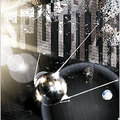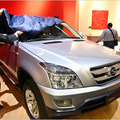
The Opel Astra GTC with panoramic windshield is available in Europe.
THE sky may be the limit, but the roof no longer is, at least to auto designers seeking a competitive advantage. While much of their attention has recently focused on the resurgence of retractable metal hardtops, many of this fall’s new models will stake their claims to novelty on skylights.
The naming of the new skylights suggests that the automakers’ knack for labeling their products remains strong. The companies that invented memorable names like Vista-Cruiser, Hydra-Matic and Stow ’n Go now offer UltraView, Sky Slider and Vista Roof. Still, at least one mystery of roof nomenclature remains unresolved: how sunroof came to mean a skylight that opens and moonroof became the designation for a fixed one.
The Sky Slider top on the new 2008 Jeep Liberty is a canvas roof. Recalling the roofs of ancient models like the Citroën 2CV, the Sky Slider slides forward or backward to open the passenger compartment to sun and sky.
Another substitute for glass is on the Mini Cooper, which offers the option of a double sunroof with sliding screen mesh panels.
Cadillac’s panoramic UltraView double sunroof, which made its debut on the SRX crossover, is shared with a sedan model, the 2008 CTS.
The Vista Roof, a name that evokes 1960s station wagons, is Ford’s double skylight. It is on the Ford Edge and Lincoln MKX. It matches a fixed window with one that slides and tilts; cloth shades can be drawn to shadow the entire glass area.
“The Vista Roof was inspired by the openness of urban lofts,” said Ed Golden, design director for the Edge and the MKX, when the Edge was introduced. “We were looking for that feel of large, open rooms.”
The new roof configurations are important selling points. Panorama has been a magic word with Americans since the 19th century, when impresarios like P. T. Barnum charged admission for a glimpse of the vast paintings called panoramas. They were the Imax cinemas of their day.
In 1952, General Motors and Libby-Owens-Ford, the glass company, announced a new curved windshield; this panoramic wraparound glass became a trademark of Harley Earl’s G.M. cars of the era, and a staple of the car salesman’s pitch. Similarly, Lincoln’s recent television advertisements for the MKX do not boast of a powerful engine or smooth transmission, but of the panoramic Vista Roof.
There is a lot of window shopping at play here.
Competition has driven the innovations, said Gary Vasilash, editor in chief of Automotive Design & Production magazine. He said new glass technology made the roofs possible.
Perhaps the most striking recent effort with roof glass is offered on the Opel Astra GTC in Europe. The panoramic windshield sweeps from the rear edge of the hood to the roof pillar behind the driver’s head and brings increased visibility to the front-seat passengers.
When Opel first showed the widescreen windshield, the designer credited with the original concept, Matthias Hallik, boasted that it would bring passengers a new sense of space — like flying. The car is coming to the United States later this year as the Saturn Astra, but without the panoramic windshield.
Of course, as in real estate, a view will cost you: Jeep’s Sky Slider option lists for $1,200; the Ford Edge’s Vista Roof goes for $1,395.





